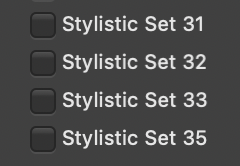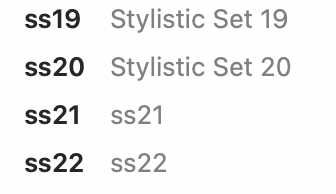In the current version of Glyphs 3 it is possible to export ss21 and above without any issues, and the features work as intended in the applications that support them.
There is however a few caveats. ss30 and above will not export if given a feature name, an entry that the program allows you to make use of.
When you try to export a stylistic set that is not ss01 - ss29 with a feature name attached you’ll get the following error message.

At the moment, this how Glyphs 3 treats stylistic sets.
ss01 - ss20 : can be exported, has name box, will export if given name
ss21 - ss29 : can be exported, has name box, will export if given name
ss30 - ss99 : can be exported, has name box, will not export if given name
I find it somewhat odd that one can export ss21-ss29 with feature names but not ss30-ss99.

an example of how stylistic sets 30 and above looks in applications without a feature name attached.
While ss21 and above are not at the moment an official part of the opentype specification, it is very likely that they’ll be made official at some point in the near future. Multiple programs already supports these stylistic sets, and it would therefore be beneficial to export these stylistic sets with names attached for use in those applications.
Glyphs already supports ss21 - ss29 almost in full. The only thing that appears to differentiate them from ss01 - ss20 is that their default feature names are listed as “ssxx” instead of “stylistic set xx”. This does not have any effect on how the features works in Glyphs however.

Since ss21 - ss29, while not part of the opentype specification, is supported in full in Glyphs 3, I see no problem with adding full support for rest of the set.
